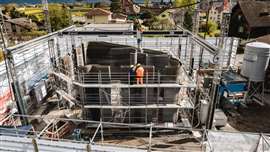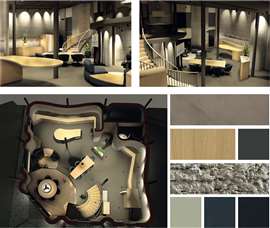Holcim, Peri claim 3D-printing ‘first’ in Switzerland
31 May 2024
Holcim, a global provider of building materials and aggregates, said it constructed on-site in St. Gallen, Switzerland, a 3D concrete-printed building for a client, with assistance from Peri. According to Holcim, it’s a ‘first’ for the country.
 Holcim, Peri, and COBOD collaborate on this ‘first in Switzerland’ on-site 3D concrete printed building. (Image: COBOD)
Holcim, Peri, and COBOD collaborate on this ‘first in Switzerland’ on-site 3D concrete printed building. (Image: COBOD)
The scheme was a 150m2 (1,614 sq ft) model showroom for construction and renovation firm Kobelt AG. The structure features curved concrete walls printed up to a height of 6.2m (20 ft).
The printer was a BOD2 3D construction unit from Denmark-based COBOD. Both Holcim and Peri, the German-based formwork and scaffolding manufacturer, are minority shareholders of COBOD.
About 60m3 (2,119 cu ft) of Holcim’s novel concrete mix was used, which was a departure from the mortar mix generally used across the 3D-printing segment.
Henrik Lund-Nielsen, COBOD’s founder and general manager, commented, “We congratulate Holcim on the development of the new 3D printable real concrete.
“For long we have been advocating printing with real concrete and not mortars, as the printing with mortars leads to use of more cement, higher CO2 emissions and costs.”
 Renders of the showroom and, on bottom right, the materials and colour schemes used for the 3D-printed structure. (Image provided by Holcim)
Renders of the showroom and, on bottom right, the materials and colour schemes used for the 3D-printed structure. (Image provided by Holcim)
The project runtime was 55 hours across eight days.
Exploring the possibilities of 3D printing
According to Holcim, Kobelt – which has experience predominantly constructing with wood – contacted the materials and aggregates group to “explore and test the possibilities of 3D printing in construction”.
Recognising the need for a showroom, but with limited space, Kobelt reached out to Holcim.
“Recognizing the novelty of the technology, Holcim Switzerland partnered with the experienced Peri 3D Construction to assist with the project,” said Holcim.
The structure was based on minimalist designs that combine wood with the concrete printed walls.
Serving as a model office space, the building contains divided zones including meeting areas, sample displays, a children’s corner, a coffee kitchen, and a separate meeting room accessed by a rounded staircase.
Lund-Nielsen noted the initiative also helped showcase the sustainability and efficiency gains of concrete-printed buildings and encouraged the segment to explore non-mortar pastes for the future.
“We need to lower the CO2 footprint of the construction sector,” he said. “This we can achieve by 3D-printing material-efficient designs with real concrete, not mortars.”
STAY CONNECTED



Receive the information you need when you need it through our world-leading magazines, newsletters and daily briefings.
CONNECT WITH THE TEAM








